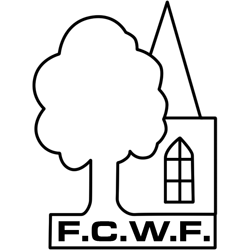This page is a catalogue of lichen that has been found in Childwall Woods and Fields.
Lichens are part of the fungi kingdom but contain elements of bacteria or algae in a mutualistic relationship. They are plantlike but do not have roots to absorb nutrients as plants do, relying on the atmosphere for their water and nutrients. They can be seen growing on bark, stone, walls, roofs, and many other surfaces in many different environments. Some are barely visible to the human eye, but stunning when magnified to show the intricacies of their hidden world.
Here are the ones in Childwall Woods. Maybe you have seen them.
Common Powderhorn, Cladonia coniocraea,
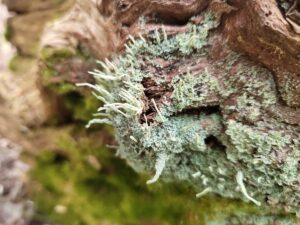
This spikey lichen commonly grows on shady rotting stumps or the base of trees. If you look closely at the spikes you will see tiny discs or cups on some tips.
This lichen is common throughout the world and in our woods. Have a look and see if you can spot it.
Shield Lichen Parmelia sulcata
You will find this little lichen on twigs throughout the woods and fields.
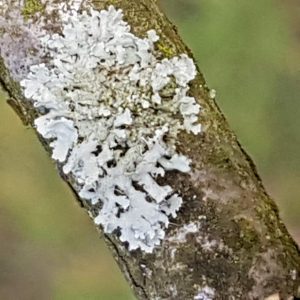
Its tiny rosettes that you will find on many branches are a colony of microorganisms made up of both algae and fungus living together in a mutualistic relationship. The algae turn sunlight into carbohydrates for the fungi and receive some nutrients and vitamins back in return.
These wonderful slow-growing colonies are widespread throughout the world and some have been found that are 5000 years old.
Golden Shield Lichen, Xanthoria parientina
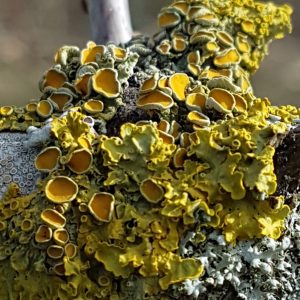
This beautiful orange/yellow lichen is one of the Sunburst Lichens.
Its tiny cups are barely visible on the branches where it lives on the oak trees of the top field.
In a sunny position, this lichen will produce more of its orange chemical which acts as a UV filter against the sun. If in a shaded area, it will revert to green.
Fluffy Dust Lichen, Lepraria finkii
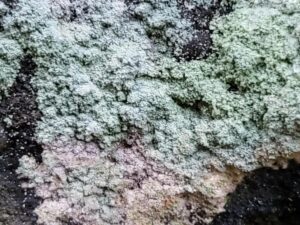
You will see this fluffy light green Lichen throughout the woods on the shady side of tree trunks, especially where dogs have urinated. If you were to look at it under a microscope you would be able to see tiny spherical outcrops called Soredium, that give the fluffy look to the lichen.
The Soredium are the reproductive growths and consist of fungal hyphae (tiny threads of fungus) wrapped around green algae. The fungal hyphae make the framework for the body of the organism and the tiny Soredium are released to perpetuate the species.
It is one of the most common lichens and is found throughout the world.
Farinose Cartilage Lichen, Ramalina farinacea
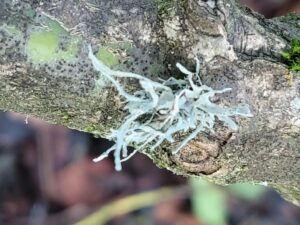
This small bushy lichen can be seen throughout Childwall Woods if you care to look at tree branches carefully. It is epiphytic, (grows on other plants) and seems to favour oak trees on our site.
It has 2 types of green algae in its coexisting in its structure and as these prefer different temperatures and strengths of sunlight, it is thought that between them, they enable the lichen to thrive in a wide range of environments.
It releases its spores from the edges of its long flat branches. When the time is right.
Comma Lichens Genus Arthonia
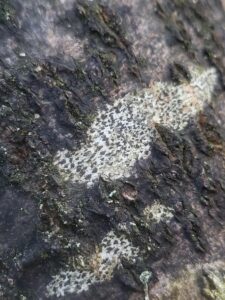
Opegrapha is a fungus that has been colonised by algae in a mutualistic relationship. There are many types of Opegrapha in the family which vary only slightly according to the type of algae that is present. The fungal hyphae (threads) spread around the algae to create the spotted pattern seen above.
Strangely this lichen is rare in the deciduous woodlands but is on many of the oaks in the wetlands of the fields. Can you find it?
Gold Dust Lichen, Chrysothrix candelaris
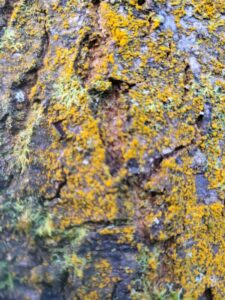
Gold dust lichen is common in the UK and is often seen on the bark of old veteran deciduous trees. In that case, Childwall Woods is the perfect place to see it. It is a powdery type of lichen and does not show the usual small round reproductive spore sacs seen on most lichen. Instead, its powdery spores are scattered all over its structure, giving them every chance of being carried away on the wind or maybe the fur of a passing squirrel.
Hooded Rosette Lichen, Physcia adscendens
Irregular branches of greyish green growing in a rosette shape but not lying flat onto its host. Underneath each branch, you will find fine filaments of fungal hyphae that hold it in place.
You will see the light green rosettes of this lichen on the branches of many small oaks on the fields, but it is only when you take a closer look that you see how it got its name.
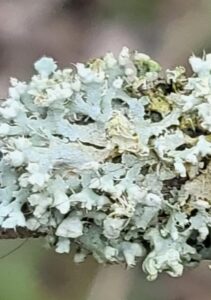
The tips of its branches curl to produce small white helmets which look almost like buds but these are not the ‘soralia’, the reproductive structures of the lichen. It reproduces by creating small packages of all its component algae wrapped in fungal hyphae which are dispersed in the wind to find new hosts.
Speckled Sheild, Genus Punctelia
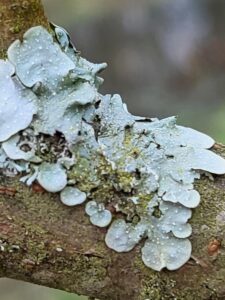
Large, leafy lichen that grows on the branches of trees and rarely on stone. Its speckles are tiny white spores that are spread all over its structure.
This lichen is particularly sensitive to pollution and can be used as a gauge for air purity. We seem to have good air on the fields where this specimen was found.
Lecidella Lichen Lecidella elaeochroma
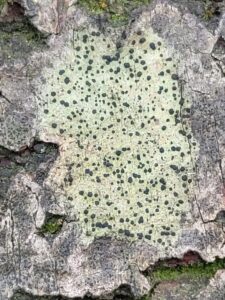
This species of lichen is mostly found on the bark of some trees. This one is on an alder on the top field.
It lies flat on its host like a crust, forming an oval or round growth.
The algae in this species is responsible for photosynthesis and that is where the lichen gets the compounds it needs to live. The fungus provides the thin structure of the lichen while the algae provides the food. A great mutually beneficial partnership.
This species is widespread throughout temperate regions of the world.
Fringed Rosette Lichen Physcia tenella
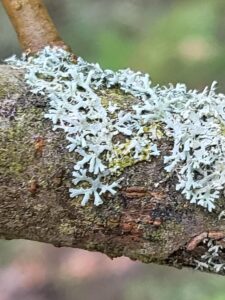
A cousin of the Hooded Rosette Lichen, shown above, this lichen can cover trees as small patches join together to form a wide blanket across the branch. The end of each branch splits when mature and the ‘soralia’, the reproductive structures of the lichen are exposed.
It is seen throughout Northern America and Europe, and on many of our trees on the top field.
If you see a lichen in Childwall Woods and Fields, send us a photo and help us to build up our collection.
bcfcwf@gmail.com
Brenda Cameron
All photographs are the author’s own.
If you like what you see on this page, why not join the Friends of Childwall Woods and Fields here?
Everything on this page has been identified as accurately as possible however with so many species existing, errors are a possibility.
12/1/2024

